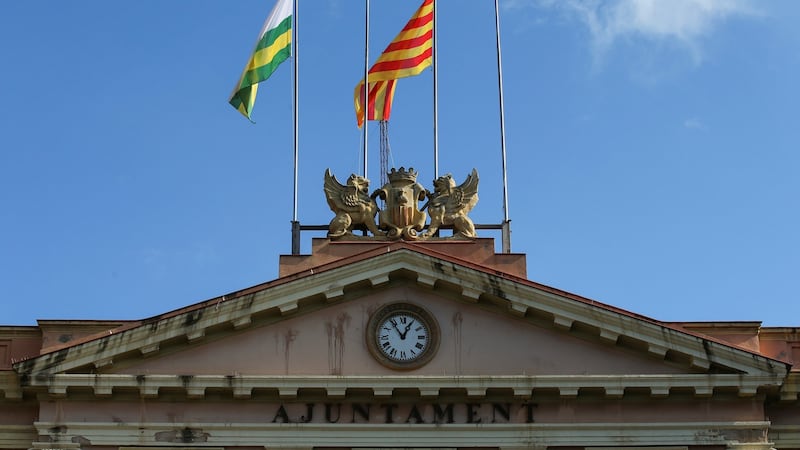At the top of the impressive façade of Sabadell town hall, above a pair of stone gargoyles, two flags are flying: the green-and-yellow of the city’s banner and the red-and-yellow stripes of Catalonia. Next to them, two flag masts are conspicuously bare. Until last Friday, the Spanish and European colours were hanging from them, but after the Catalan parliament issued a declaration of independence that day, members of the local council took both down.
The man who gave permission for that step was Maties Serracant, the pro-independence mayor of Sabadell.
“We know we’re not yet in a Catalan republic, but those symbols don’t make sense given the times we are living through in Catalonia,” Serracant says, speaking in his office inside Sabadell town hall.
Many were surprised by the removal of the EU flag, given the independence movement's pro-European convictions. But the move reflects widespread disappointment among secessionists at the bloc's refusal to intervene in the Catalan crisis. Serracant describes the removal of the flags as "a complaint, not just against Spain but also against the EU, because we believe that Europe isn't helping or supporting Catalonia in its legitimate claim to self-determination".
Serracant represents a leftist coalition, Crida per Sabadell, which controls the town hall with the support of other leftist and pro-independence forces. But the flag withdrawal has drawn an angry response.
Serracant and his allies “have declared themselves in rebellion and they want to corral those who don’t support them”, says José Luis Fernández, of the unionist Ciudadanos party, which has since hung a Spanish flag from the window of its offices on the ground floor of the town hall building.
‘Disparagement and abuse’
Despite the drama of the flag episode, Serracant hardly comes across as a separatist firebrand. A softly spoken environmentalist activist, he only converted to the independence cause over the last decade, in response to what he says was the Spanish government’s attitude of “disparagement and abuse” towards Catalonia.
He and many others believe that attitude has been amply represented by Madrid’s response to last week’s proclamation of independence: the very same day, it introduced direct rule in Catalonia, via the use of article 155 of the constitution.

On Monday, when many people expected to see some form of civil unrest to resist the implementation of article 155, there was almost total calm. Meanwhile, the deposed Catalan president, Carles Puigdemont, secretly fled to Brussels with several former members of his cabinet. He has since claimed to be continuing his work as Catalan leader there.
Given such a dramatic series of events, there is a sense that Spanish prime minister Mariano Rajoy, who has called a Catalan election for December 21st, has taken the upper hand in this crisis. A frequent accusation by unionists is that those who continue to campaign for independence are detached from reality. Albert Rivera, leader of Ciudadanos, quipped that Puigdemont was behaving like a character in the fantasy film The Matrix. Spanish foreign minister Alfonso Dastis said he was "living in a parallel world".
Serracant, while he insists his own course of action is rooted in reality, admits to feeling a degree of uncertainty.
“There are some developments which are hard to understand,” he says, when asked about Puigdemont’s flight. “They are hard for me to understand, even though I’m mayor of the fifth-biggest city in Catalonia.”
The region’s current situation, he says, is extraordinary, although recent events have not totally quenched his optimism. “We feel we’re in a transition between the Spanish state and the Catalan republic,” he says. “We’re living in uncertainty.”
Business as usual
Out on the streets of Sabadell, there is little to suggest either that a revolution has been under way or that the region has been robbed of its devolved powers. People go about their business and public services operate as normal in the town that was once known as “the Manchester of Catalonia”, due to its industrial heritage. Many pro-independence flags – similar to the Catalan symbol, but with a white star – hang from the balconies of apartment blocks. Very occasionally a Spanish flag is visible.
Guillermo Fernández is still excited by last week’s declaration of independence. Smoking a cigarette on the steps leading to Sabadell’s underground railway, the 23 year old recalls how his mother rang him to tell him the news when he was at work. “It’s a moment I will never forget, it was a very special day,” he says.
Clearly unsettled by the idea of direct rule, he nonetheless has a similarly upbeat mindset to that of his mayor.
“I’m happy because we’re a republic but I think it’s just getting started and we have to do a lot of things,” he says. Yet the timeframe he suggests for achieving a full, legal breakaway shows how much expectations in the separatist camp have dropped recently.
“The beginning is never easy,” he says. “But maybe in seven, eight or 10 years we’ll be in a better situation.”
María Fernández, a student who describes herself as a “Spanish republican”, says she was converted to the independence cause after witnessing Spanish police violence during the October 1st independence referendum organised by Puigdemont’s administration.
“I don’t identify with Puigdemont,” she says, describing him as a representative of the Catalan bourgeoisie. “I’d like independence but not with Puigdemont.”
But despite her newly found separatist convictions, Fernández is less upbeat than many others in Sabadell about achieving that goal. “We’re not independent yet,” she says. “We’ve got a long way to go.”










